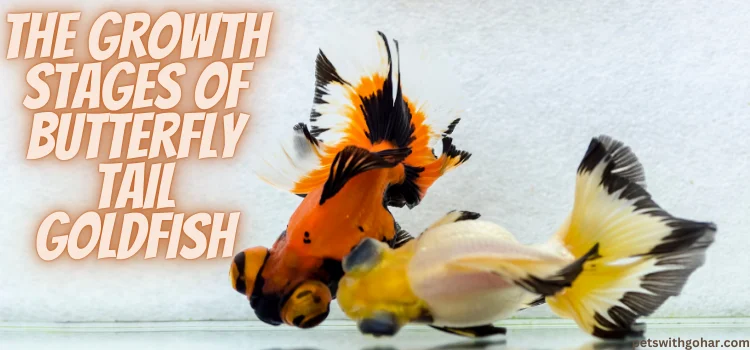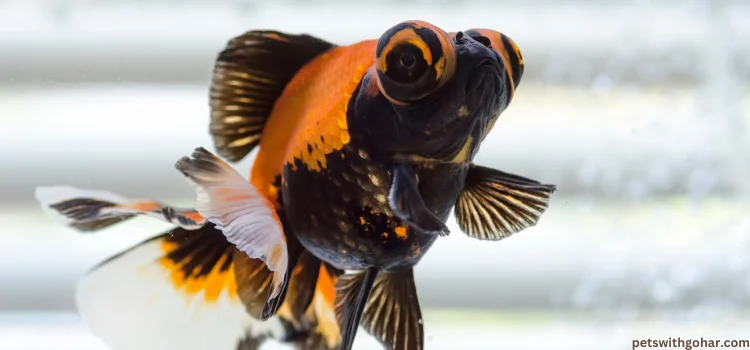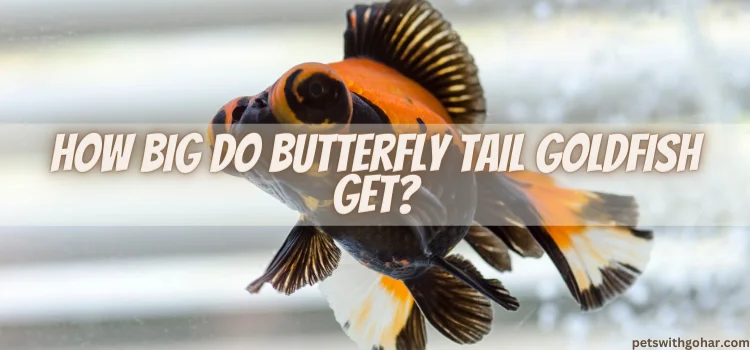Butterfly tail goldfish typically grow between 6 to 8 inches long, with some reaching up to 10 to 12 inches under optimal conditions.
Their size can be influenced by various factors such as genetics, diet, the quality and length of their tank, and their overall health.
Butterfly tail goldfish can grow to impressive sizes when correctly cared for. They can reach lengths of up to 8 inches (20 cm) or more in optimal conditions. Their growth largely depends on tank size, water quality, diet, and genetics.
To ensure your butterfly tail goldfish reaches its full potential size, provide them with a spacious aquarium, ideally 20 gallons or more per fish. Maintain clean and well-filtered water and feed them a balanced diet of high-quality goldfish pellets or flakes, supplemented with occasional treats like live or frozen foods.
Following these guidelines and giving your butterfly tail goldfish the proper care, you can expect them to grow to a healthy and impressive size. Remember, proper care is crucial in helping your goldfish reach its full growth potential.
Understanding The Size Growth Of Butterfly Tail Goldfish.
As their name suggests, butterfly-tail goldfish are highly sought after for their unique tail resembling a butterfly’s wings.
This tail adds a touch of beauty to any tank. A butterfly tail goldfish’s growth is steady and moderate throughout its life span, typically reaching around 6-8 inches in size, But it can grow up to 10 inches in optimal conditions.
The growth of a butterfly tail goldfish can be affected by various factors, which we will explore in more detail below.
Exploring The Growth Stages Of Butterfly Tail Goldfish.

Understanding the growth stages of butterfly tail goldfish is more than just interesting. It’s vital for any enthusiast or potential owner.
Butterfly tail goldfish begin their life cycle as eggs, typically laid on the tank’s aquatic plants. These eggs are tiny and fragile.
With the proper water temperature (around 68-74 degrees Fahrenheit) and other conditions, these eggs hatch in about 4-7 days into what is known as fry.
During the fry stage, which lasts for a few weeks, they are small, thin, and delicate. They snowball during this period, consuming yolk sacs for the first few days and then moving on to small foods like infusoria or newly hatched brine shrimp. At this stage, they don’t resemble the adult butterfly tail goldfish.
As the fry grows over the next few months, they enter the juvenile stage. Here, the fry starts developing its distinctive butterfly-shaped tail, and its color changes.
Some goldfish may begin to exhibit the gold or orange hues they’re known for, while others may remain silvery or grayish for longer.
Once the butterfly tail goldfish reach about a year old, they are considered adults. Adult butterfly-tail goldfish will continue to grow, albeit at a slower pace.
In optimal conditions, butterfly tail goldfish can live for up to 15 years, sometimes even longer, each growth stage providing a unique observation experience for the aquarist.
How To Measure The Size Of Your Butterfly Tail Goldfish.
Measuring your butterfly tail goldfish might seem like a daunting task, especially when they’re swimming around, but it’s pretty straightforward. Here are the steps:
- Please wait for the Right Moment: Measuring your goldfish when it’s still easier. This can be during feeding times or when the lights are dim.
- Use a Measuring Tape or Ruler: A soft measuring tape or a ruler works best. Lay it along the side of the aquarium to avoid disturbing the fish.
- Measure from Nose to Base of Tail: Start from the tip of the nose and measure to the base of the tail (the caudal peduncle). The standard way to measure fish does not include the tail length, as the tail size can vary significantly between individuals.
- Repeat for Accuracy: Because your goldfish is likely moving, measuring a few times is a good idea to ensure accuracy. Take the average of these measurements to determine the length of your butterfly tail goldfish.
Factors Influencing The Size of Butterfly Tail Goldfish.

The size of butterfly-tail goldfish can be influenced by several key factors, such as diet, genetics, and the environment in which they are kept. Understanding these factors can help your goldfish reach its maximum potential size.
The Role of Genetics in Butterfly Tail Goldfish Size.
Like many other species, the size of butterfly tail goldfish can be primarily influenced by their genetic makeup.
Despite all other conditions being perfect, some goldfish may grow more minor than others due to their genetics.
This is why choosing goldfish from reputable breeders is essential, who often have genetic solid lines that allow maximum growth.
Feeding for Growth: What Butterfly Tail Goldfish Need to Thrive.
Your diet for your butterfly tail goldfish can significantly influence their size. They are omnivores and require a balanced diet of plant and animal matter.
Feed them high-quality goldfish pellets as a staple, supplemented with fresh vegetables and occasional protein treats like brine shrimp or bloodworms.
Butterfly Tail Goldfish Size: The Effect of Tank Conditions.
The environment in which your goldfish live can also impact their size. Butterfly tail goldfish are sensitive to poor water quality, which can stunt their growth and cause health problems.
Keeping the tank clean, ensuring proper filtration, and maintaining the right temperature and pH levels are essential for their development.
How Aquarium Size Affects Butterfly Tail Goldfish Growth.
The aquarium size can also affect the growth of your butterfly tail goldfish. A giant aquarium allows your goldfish to grow more prominent because it can handle the higher levels of waste produced by larger fish and give them more room to swim.
The Size Range of Butterfly Tail Goldfish
Butterfly-tail goldfish are known for their vibrant colors, graceful movement, and, most importantly, their butterfly-shaped tail.
When it comes to their size, under ideal conditions, butterfly tail goldfish usually grow to be between 6 to 8 inches in length.
With excellent care, adequate space, and good genetics, these beautiful fish can grow even larger, reaching up to 10 to 12 inches.
Predicting the Adult Size of Your Butterfly Tail Goldfish
If you’re wondering about the eventual size of your butterfly tail goldfish, there are vital factors to consider for an accurate prediction.
1. Genetics: The primary determinant of your goldfish’s size is its genetics. Different breeds have varying growth potentials. Butterfly tail goldfish can typically reach lengths of
2. Tank Size: Providing ample space is essential. For optimal growth, house your goldfish. This ensures they have room to swim and grow comfortably.
3. Water Quality: Maintaining pristine water conditions is crucial. Regular water changes, proper filtration, and aeration promote healthy growth.
4. Diet: A balanced diet is essential. Feed high-quality goldfish pellets or flakes supplemented with occasional live or frozen foods. Proper nutrition supports healthy development.
By focusing on these factors and providing the proper care, you can predict your butterfly tail goldfish’s adult size more accurately. Remember that attentive care is critical to helping your goldfish reach its full growth potential.
While it’s challenging to predict the exact adult size of your butterfly tail goldfish, you can make an educated guess based on several factors.
Firstly, genetics play a significant role. Knowing the size of the fish’s parents or siblings can give you a clue as to how large your fish might get.
Secondly, diet and environment significantly impact growth. Fish that are well-fed and kept in good conditions will likely grow more prominent.
Common Misconceptions About Butterfly Tail Goldfish Size
One of the most widespread misconceptions about butterfly tail goldfish, and indeed all goldfish, is that they will only grow to fit the size of their tank.
This myth likely originated from the observation that goldfish often appear to grow less in smaller tanks.
Restricted growth is not a healthy adaptation; instead, it indicates inadequate conditions stifling the fish’s growth potential.
The goldfish’s growth is stunted in a smaller tank due to poor water quality, stress, lack of exercise, and inadequate nutrition.
Their bodies may be small, but their internal organs can continue to grow, causing severe health issues.
Another misconception is that goldfish remain small throughout their lifetime. Goldfish are a larger pet fish species, with some varieties reaching over a foot in length.
Butterfly tail goldfish, while not typically as large as some other varieties, can still run a significant size, as mentioned above.
Conclusion.
Butterfly tail goldfish are magnificent creatures that can grow quite large under the right conditions.
A combination of factors, including genetics, diet, and environment, influences these fish’s growth and size.
Debunking misconceptions and understanding these factors can help owners provide the best care for their butterfly-tail goldfish, enabling them to reach their full growth potential and lead healthy, happy lives.
Frequently Asked Questions.
What size tank does a Butterfly Tail goldfish need?
Butterfly tail goldfish need a lot of space due to their potential size and the high amount of waste they produce. A single butterfly tail goldfish should have at least a 20-30 gallon tank, but a larger one would be even better.
What kind of goldfish grow big?
Common goldfish and comet goldfish grow the largest, often reaching up to 12 inches or more. Butterfly tail goldfish can grow quite large, reaching up to 10 to 12 inches under optimal conditions.
Can butterfly goldfish live with other fish?
Yes, butterfly-tail goldfish can live with other fish, but it’s best to keep them with different goldfish varieties that are similar in size and temperament. They can also cohabitate with peaceful, slow-moving species that prefer identical water conditions.
How big do single-tail goldfish get?
Single-tail goldfish, like common goldfish and comets, can grow quite large, often reaching lengths of 12 inches or more in a properly maintained environment.
Do Butterflyfish eat small fish?
Butterflyfish are mostly carnivorous; some species can and will eat small fish or shrimp. However, despite their name, butterfly-tail goldfish are omnivorous and do not typically eat small fish.
What do butterfly goldfish eat?
Butterfly tail goldfish thrive on a balanced diet of high-quality goldfish pellets and occasional feedings of vegetables and live or frozen foods like daphnia, brine shrimp, or bloodworms.
What do butterfly goldfish eat?
Butterfly tail goldfish thrive on a balanced diet of high-quality goldfish pellets and occasional feedings of vegetables and live or frozen foods like daphnia, brine shrimp, or bloodworms.
Can two goldfish mate?
Yes, two goldfish can mate if they are sexually mature, usually when they’re about a year old and a certain size. You can encourage breeding with a proper diet and gradually increase the water temperature.
Do goldfish eat guppies?
Goldfish are omnivorous and can eat small fish, so they can eat guppies, especially if the goldfish is significantly larger. Therefore, it’s generally not recommended to house goldfish and guppies in the same tank.

